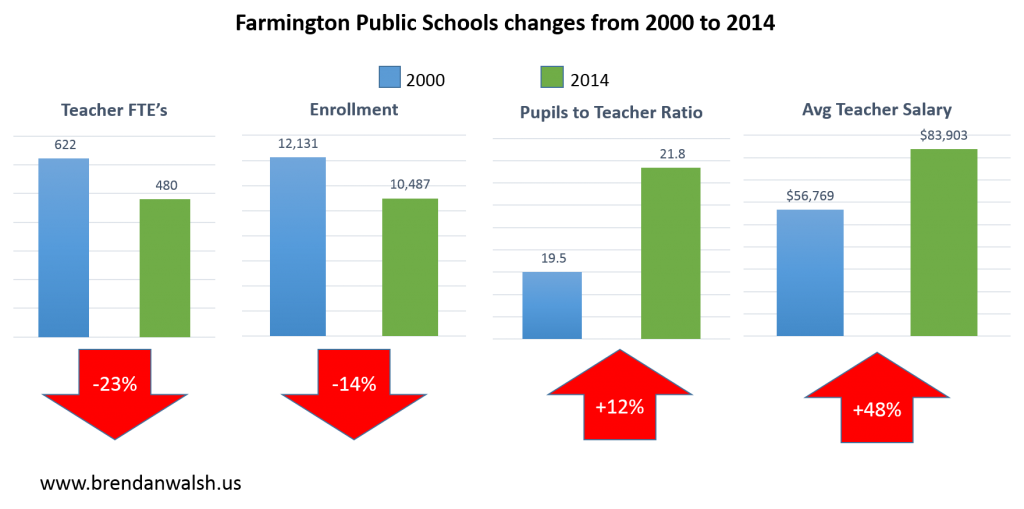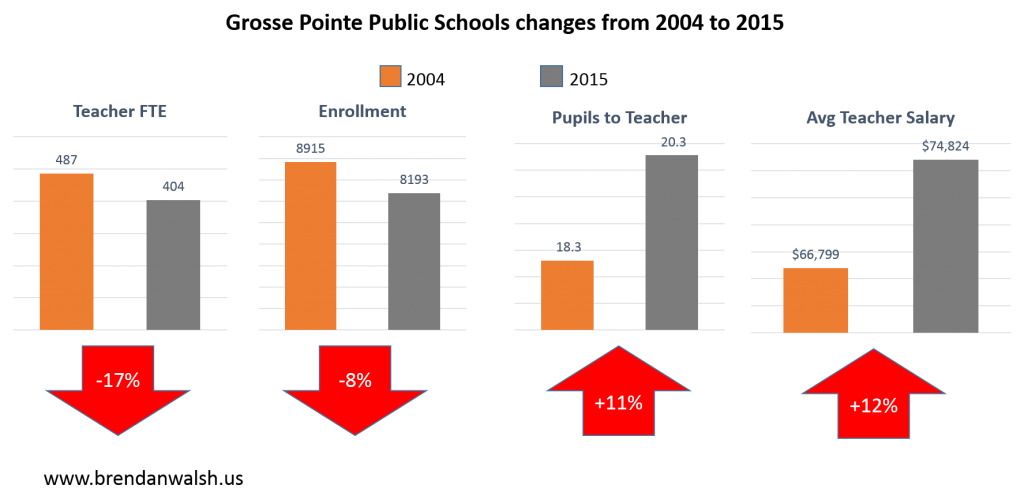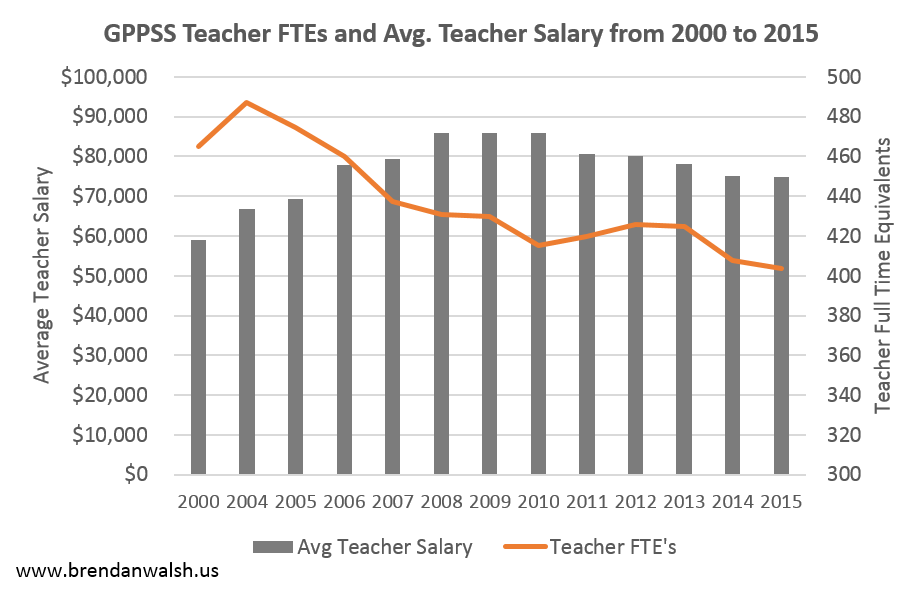Things are pretty bad at Farmington Public Schools these days, the Detroit News reported last week:
Farmington Public Schools should close or repurpose three schools, including a high school, the superintendent said Tuesday, unveiling his recommendations for downsizing the district…
“I believe, and the enrollment numbers demonstrate, that the continued projected enrollment decline has created excess student capacity in the system,” said Superintendent George Heitsch.
District enrollment has dropped 12.3 percent since 2000.
Farmington Public Schools also made news recently for having the highest average teacher salaries in the state. The dynamic between enrollment and average teacher salary is worth exploring.
When school districts experience enrollment loss, they cut teaching staff. Teacher contracts are of the “last in, first out” variety. The first teachers who lose their jobs are those most recently hired and therefore have the lowest salaries. Starting salaries are typically less than half the average of all the teachers in the district. Slashing low cost teachers drives average salary higher.
This is not just a statistical issue, but a real problem. It means the cost of providing the same services before enrollment loss gets more expensive. Let’s take a closer look at these dynamics in Farmington since 2000:
Not a whole lot of good things are happening here. In response to budget constraints and enrollment loss, Farmington has reduced its teaching staff by nearly a quarter – a rate far exceeding the 14% enrollment loss. This results in a 12% increase in the ratio of students to teachers. This means class sizes are probably getting bigger and/or students have fewer course choices. In Farmington, they’ll soon have fewer schools.
The massive increase (48%) in average teacher salary is mostly a function of the 23% reduction in teaching staff, who were on the lower end of the salary scale.
Worst of all, this strategy has not worked. Farmington ran a $7 million deficit is 2014, a $3 million deficit in 2015, and now in 2016 they are discussing closing schools.
We’ve seen this movie in Grosse Pointe and to some extent we’re still living it, but with some major differences. Let’s take a look at similar data for the GPPSS.
The dynamics here are similar. 8% enrollment loss led to a 17% reduction in teaching staff. This drove up the student to teacher ratio at about the same rate as Farmington’s.
What the GPPSS data does not show is the fluctuations in average teacher salary within this time period.
At its peak in 2010, the GPPSS average teacher salary reached $85,851 – slightly below Farmington’s current levels. GPPSS then, like Farmington now, had the highest average teacher salary in the state.
But average salary went down in the GPPSS between 2010 and 2015 for two main reasons. The first was an early retirement incentive that was part of the 2010 teacher contract. 80 teachers took the offer and the district’s highest paid staff left the payrolls. The second reason was the contract’s salary reduction triggers once fund equity went below 10%. Average salaries went down about 7% as a result.
Without these, the GPPSS would be talking about closing schools just as they are in Farmington. Where Farmington has tried to control cost by continuing to reduce staff faster than enrollment loss, the GPPSS spread salary cost reduction across all teaching staff and therefore averted the crisis Farmington now faces.
Despite these cost controls in Grosse Pointe, the financial situation is still tenuous, but certainly not anywhere nearly as bad as Farmington’s. Enrollment declines remain a major problem in Grosse Pointe. This year the GPPSS experienced a 2.2% decline in enrollment, the second largest loss of students in the last 12 years.
For now, the key message is that slashing teaching positions in response to declining enrollment is not in itself a viable financial management strategy. Grosse Pointe had the vision to see this in 2010 and Farmington is learning the hard way right now. With a neighborhood school structure, no buses, and just two high schools, closing schools in the GPPSS is a much more daunting proposition. We don’t want to be there.
This dynamic of enrollment loss and teacher employment levels raises many questions about what is the right and fair approach to balancing budgets in districts with declining enrollment. We will look at this in more detail soon.



8 responses to “The difficult dynamic of enrollment and teacher salaries”
I appreciate and enjoy your infrequent communications; for they are very worth reading. Saying that though, I do disagree with two of your statements, “Teacher contracts are of the “last in, first out” variety. The first teachers who lose their jobs are those most recently hired and therefore have the lowest salaries. Starting salaries are typically half that of district averages of all teachers. Slashing low cost teachers drives average salary higher” and “The massive increase (48%) in average teacher salary is mostly a function of the 23% reduction in teaching staff, who were on the lower end of the salary scale.” Although teacher layoffs do happen for a variety of reasons, because of new school law, boards cannot layoff teachers based on seniority alone, although it probably still leans in that direction.
The main difference perhaps in your comparison of Farmington Public Schools and Grosse Pointe Public Schools, regarding average teacher salary, is because Grosse Pointe had a buyout of senior teachers and Farmington didn’t.
Hi Ed,
Thanks for the kind words and for reading. I have been meaning to post more often and will try to do so.
I agree that technically LIFO is not allowed in strict terms, but as you state, it is certainly the norm.
I have pretty good data on the effect of the ERI. We ran it in GPPSS in the spring of 2010, a year in which we had 415 teacher FTE’s at an average of $85,851. 80 teachers took the ERI and in 2011, we actually increased our teacher FTE count to 420 – and the average salary was $80,566. So the ERI then reduced average salary by about $5,000 per teacher.
To get from the then $80,566 to the current $74,824, the average needed to drop another $6,000. This 7% drop is about equal to the across the board salary reductions embedded in the teacher contracts – about -2% in 2013 and another -4.9% in 2014.
Brendan
[…] I posted about the dynamics of declining enrollment and teacher staffing levels and salary. While doing the […]
[…] contributor to the regression is enrollment reduction. This is why I have been writing about Farmington’s troubles as well as the clear and unfortunate trajectory of enrollment loss for the GPPSS. The bear that has […]
[…] flat or falling revenues, particularly due to declining enrollment, increasing average teacher salaries is commonly followed by teacher staff reductions. […]
[…] and for the vast majority of Michigan districts’ enrollment has declined (good read on that here.) The only real way to create a perpetually and structurally balanced budget is to establish a […]
[…] could add a third issue – declining enrollment. To me, this is the source of most of the district’s financial problems. I am skeptical that outside of open enrollment/school of choice, that the local school board alone […]
[…] $8.5 million per year. I have written a ton about the problems caused by declining enrollment. Read this one for a […]